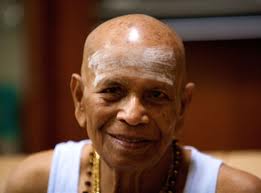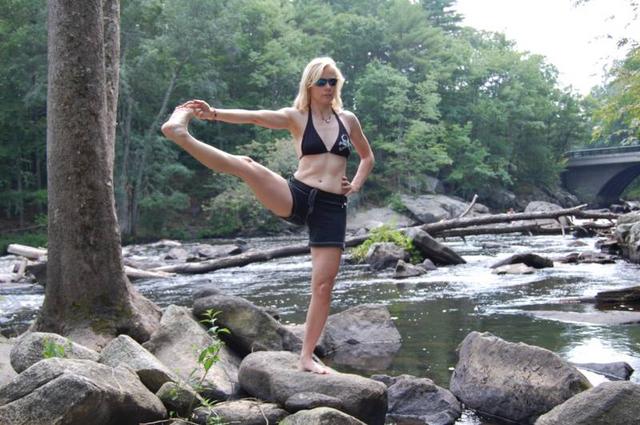Ashtanga Yoga
Ashtanga Vinyasa Yoga or Ashtanga Yoga is a system of yoga popularized by K. Pattabhi Jois, and which is often promoted as a modern-day form of classical Indian yoga. Pattabhi Jois began his yoga studies in 1927 at the age of 12, and by 1948 had established an institute for teaching the specific yoga practice known as Ashtanga (Sanskrit for "eight-limbed") Yoga.
Power yoga and Vinyasa yoga are generic terms that may refer to any type of vigorous yoga exercise derived from Ashtanga Vinyasa Yoga.
Yoga can be practiced by anyone, whether young, old, very old, healthy or sick. Even so, the way in which a young person is taught will differ in manner from the way in which an old or sick person will be taught. Therefore, each student must be considered as an individual and taught at a pace that is suitable for their situation in life.
All students commence their instruction in the same manner in which on the first day of class they are taught Surya Namaskar A, followed by Padmasana and deep breathing, and a few minutes of rest to conclude their first day of practice. The next day after Surya Namaskar A has been performed, Surya Namaskar B is taught, and one then again concludes in the same method as the previous day, with Padmasana, deep breathing, and rest. After both of the Surya Namaskar have been learned correctly, each of the various asanas are added one by one. When one asana is correct, the next one is taught. Depending on the age and ability of the student, it can take anywhere upwards of 3 months to learn the primary series.
The format of the practice always remains the same; one always begins practice with Surya Namaskar, concludes with Padmasana and rest, and the various asanas gradually fill the space between these two poles. Learning yoga in this traditional manner benefits the student on many levels. It is possible for one to gain independence and confidence in their sadhana (spiritual practice), as well, something truly becomes one’s own when they learn it by heart. It is through the daily practice of Ashtanga Yoga that we draw it into ourselves, understand it, and become proficient in its methods, thereby reaping its wide range of benefits. For this to be accomplished, a slow, dedicated and patient approach is best.
Vinyasa means careful linking of breath and movement. The Surya Namaskar and each of the successive asanas are comprised of a particular number of vinyasas. Vinyasa creates heat in the body, which warms the blood. The warmed blood passes through the muscles, nerves, internal organs and glands, removes toxins from them, and carries them out through the sweat. This is how the process of purification begins. It is important that the student does not rush ahead doing too many asanas, and allows the body to be gradually purified. If one rushes ahead quickly, it is possible for sickness to occur, rather than purification. It is important that the teacher checks to ensure that the position of the body and the movement of breath are correct in each asana before moving the student forward so that one may reap the proper benefit of Ashtanga Yoga.
The breathing style used in Ashtanga Vinyasa Yoga is with sound which is a relaxed diaphragmatic style of breathing, characterized by an ocean sound which resonates in the practitioner's throat. Throughout a practice, this specific breathing style is maintained in alignment with movements. The steady cycle of inhales and exhales provides the practitioner with a calming, mental focal point. Additionally, Vinyasa and Ujjayi together create internal heat, which leads to purification of the body through increased circulation and sweating.
Bandhas
There are three bandhas which are considered our internal body locks, prescribed in the different asanas. The bandha is a sustained contraction of a group of muscles that assists the practitioner not only in retaining an asana but also in moving in and out of it. The Mūla Bandha, or root lock, is performed by tightening the muscles around the pelvic and perineum area. The Uḍḍīyāna Bandha, often described as bringing the navel to the base of the spine, is a contraction of the muscles of the lower abdominal area – this bandha is considered the most important bandha as it supports our breathing and encourages the development of strong core muscles. Jālaṅdhara Bandha, throat lock, is achieved by lowering the chin slightly while raising the sternum and the palate bringing the gaze to the tip of the nose
.
Drishtis
Drishti (dṛṣṭi), or focused gaze, is a means for developing concentrated intention. The most common is Ūrdhva, or upward gazing, where the eyes are lifted, with the spine aligned from crown to tailbone. This technique is employed in a variety of asanas.
There are, in total, nine drishtis that instruct the yoga student in directing his or her gaze. Each asana is associated with a particular drishti. They include:
• Aṅguṣṭha madhyai: to the thumb
Aṅguṣṭha madhyai: to the thumb
• Bhrūmadhya: to the third eye, or between the eyebrows
Bhrūmadhya: to the third eye, or between the eyebrows
• Nāsāgrai: at the tip of the nose (or a point six inches from the tip)
Nāsāgrai: at the tip of the nose (or a point six inches from the tip)
• Hastagrai: to the palm, usually the extended hand
Hastagrai: to the palm, usually the extended hand
• Pārśva: to the left/right side
Pārśva: to the left/right side
• Ūrdhva: to the sky, or upwards
Ūrdhva: to the sky, or upwards
• Nābhicakra: to the navel
Nābhicakra: to the navel
• Pādayoragrai: to the toes
Pādayoragrai: to the toes
Ashtanga Vinyasa Yoga is different from many yoga classes in the west in that the order of asanas is completely predefined. A practice will comprise four main parts: an "opening sequence," one of the six main "series", a back-bending sequence, and a set of inverted asanas, referred to as the "happy ending" or "finishing sequence." Practice always ends with savasana. The opening sequence begins with 10 Sun Salutations and then several standing asanas. Next, the practitioner will do one of the six main series, referred to as the Primary series (Yoga Chikitsa), Intermediate series (Nadi Shodhana) or Advanced A, B, C, or D (Sthira Bhaga) series level. Newcomers to Ashtanga Yoga practice the primary series, after learning the standing sequence. The Primary Series is the most important series as it forms the basis of the entire system. Practitioners may advance to more difficult series over a period of years or decades, but the goal of this style is not to learn the more difficult asanas but rather to learn to maintain internal focus throughout the practice.
Daily or regular practice is highly emphasized in Ashtanga Vinyasa Yoga. Ashtanga Yoga is traditionally taught in Mysore style (supervised self practice, named after the city in India where Ashtanga originates), where each student moves through the practice at his or her own pace and level. An individual with an established Ashtanga practice might take between an hour and two hours, depending on his or her own personal speed, but a beginner will likely have a shorter practice. It is more common to find classes devoted to a specific series, often at a standardized pace, and guided by an instructor. However, even traditional Mysore-style teachers offer "led" classes either weekly or monthly.
History and legend
The Ashtanga Vinyasa series is said to have its origin in an ancient text called the Yoga Korunta, compiled by Vamana Rishi, which Krishnamacharya received from his Guru Rama Mohan Brahmachari at Mount Kailash in the early 20th century. The story of the Yoga Korunta though finds no evidence in any historical research on the subject, it seems that no text with this name has ever been written, and the Yoga Korunta was probably just a legend created by Krishnamacharya.
Krishnamacharya has had considerable influence on many of the modern forms of yoga taught today. Among his students were many notable present-day teachers such as K. Pattabhi Jois, B.K.S. Iyengar, Indra Devi, and Krishnamacharya's son T.K.V. Desikachar. Krishnamacharya was well known for tailoring his teachings to address specific concerns of the person or group he was teaching, and a vinyasa series for adolescents is a result of this. When working under the convalescing Maharaja of Mysore, Krishnamacharya set up a shala, or yoga school in the palace grounds and adapted the practice outlined in the Yoga Korunta for the young boys who lived there. Vinyasa has since been thought of as a physically demanding practice, which can be successful at channeling the hyperactivity of young minds. This system can also be used as a vessel for helping calm ongoing chatter of the mind, reducing stress and teaching extroverted personalities to redirect their attention to their internal experience.
Sri K Pattabhi Jois
Jois was born on July 26, 1915, in the village of Kowshika, near Hassan, Karnataka, South India.
Jois's father was an astrologer, priest, and landholder. From the age of 5 he was instructed in Sanskrit and rituals by his father, as were all Brahmin boys. No one else in his family had learned yoga or even professed interest in it.
In 1927, at the age of 12, Jois attended a lecture and demonstration by T. Krishnamacharya[ and became his student the very next day. For two years Jois practiced with Krishnamacharya every day. Jois never told his family he was practicing yoga. He would rise early, go to practice, and then go to school.
In 1930, Jois ran away from home to Mysore to study Sanskrit. Two years later, Jois was reunited with Krishnamacharya, who had also made his way to Mysore. During this time, the Maharaja of Mysore had become seriously ill and it is said that Krishnamacharya had healed him, through yoga, where others had failed. The Maharaja became Krisnamacharya's patron and established a Yoga shala for him on the palace grounds. Jois often accompanied Krishnamacharya in demonstrations. Krishnamacharya remained in Mysore with Jois until 1941.
He held a teaching position in yoga at the Sanskrit College of Maharaja from 1937 to 1973, and then he left to devote himself fully to teach yoga at his yoga shala. In 1948, he established the Ashtanga Yoga Research Institute at their new home in Lakshmipuram.
In 1964, a Belgian named André Van Lysebeth (1919–2004) spent two months with Jois learning the primary and intermediate asanas of the Ashtanga Yoga system. Not long afterwards, van Lysebeth wrote a book called J'apprends le Yoga (1967, English title: Yoga Self-Taught) which mentioned Jois and included his address. This marked the beginning of westerners coming to Mysore to study yoga All his students, including the celebrities and his grandson, received the same training.
In 1975 he stayed for four months in Encinitas, California, marking the beginning of Ashtanga yoga in the US. He would return to the US several times over the next 20 years, to teach yoga at Encinitas and elsewhere.
He wrote his only book, Yoga Mālā, in Kannada in 1958, and it was published in 1962, but was not published in English until 1999. Jois continued to teach at the Ashtanga Yoga Research Institute in Mysore, now located in the neighborhood of Gokulam, with his only daughter Saraswathi Rangaswamy (b. 1941) and his grandson Sharath (b. 1971), until May 18, 2009 when he died aged 93 of natural causes.










